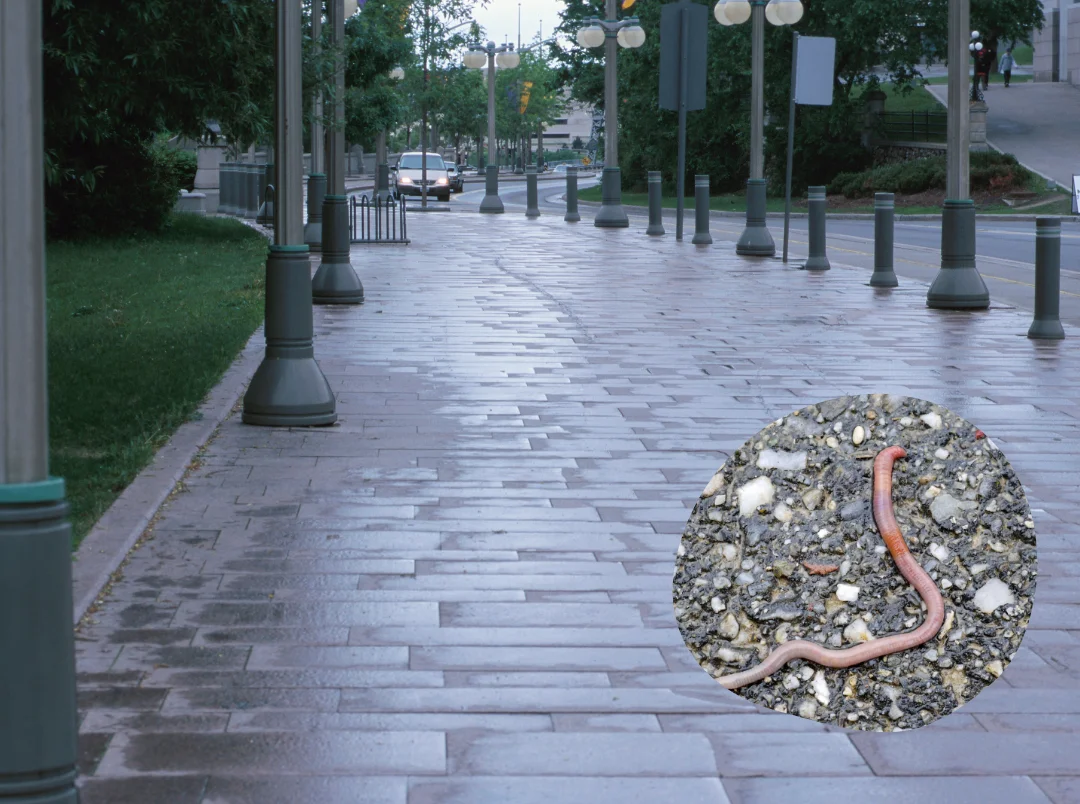Have you ever gone out after a rain and found worms all over your lawn, or along the sidewalk? While worms are usually hard at work in our yards and gardens every day, we hardly tend to see them. When the weather gets a little wet, suddenly, we’re liable to find them littering the sidewalk or trucking along the ground. So why do worms only come out when it rains?
As with some other Naturalist Answers, this one isn’t as simple as it might seem. In fact, there are three major reasons why worms might surface during or after a big rain. However, experts seem to disagree on which of them makes the most sense. Let’s explore this topic for ourselves!
Worm basics
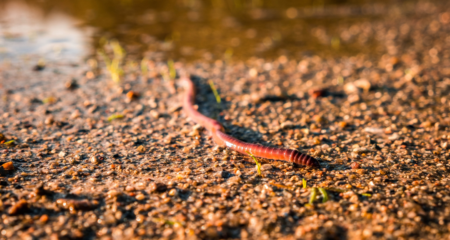
Like anything else in nature, a little background knowledge can go a long way. For starters, what we call “worms” are in fact a group of invertebrates known as earthworms. They belong to a suborder called Lumbricina of the larger subclass of oligochates, belonging to the phylum Annelida. While many other annelids you might encounter are cool critters in the ocean and on beaches, earthworms are the only members of this group that most people commonly meet.
Let’s review some quick worm facts that will be helpful for understanding their behavior:
- Earthworms breathe through their skin. They don’t have lungs like we do, or gills like fish. They can only absorb the oxygen that they need to live through a process called diffusion. This is when molecules of air pass through their body wall into their blood. Importantly, this can only happen when their skin is wet. If worms dry out, they can no longer breathe.
- Worms don’t have eyes. Although they can sense the difference between light and dark, they cannot clearly see their surroundings. This means that they need to have different ways to sense the approach of predators.
- They move by sliding. Worms move around using muscular contractions that scientists call peristalsis. This involves tightening muscles that stretch the worm forward and outward, grabbing onto a surface with little hairs called setae, and then pulling the back end of the worm up to catch up with the front end. This can be a slow process, and it involves a lot of friction with the ground.
Why do worms come out when it rains?
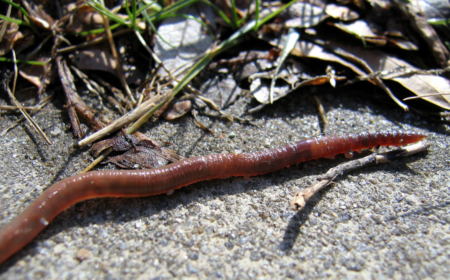
Scientists and naturalists have proposed three different reasons for why worms come out when it rains. While some articles claim that one or another of these are absolutely true and other ones aren’t, the truth of the situation is not so simple. The three main reasons why worms may come out when it rains are not what scientists would call mutually exclusive. In other words, there’s no reason that all three of them couldn’t be true in some cases.
As we’ll see, part of the confusion may come from people not understanding earthworms’ biology. The three main ideas (or hypotheses) for this weird behavior are:
- Worms are trying to avoid drowning in waterlogged soil.
- They are taking advantage of a wetter, safer environment to move longer distances.
- Raindrops make vibrations that make worms think a predator is coming, so they flee to the surface.
Here’s the scoop on each one of these hypotheses:
Getting enough oxygen
Just like any other animal, worms need oxygen to live. One of the most popular explanations for why worms come up to the surface when it rains is that they do that to avoid drowning. However, knowing that worms absorb oxygen easily through their wet skin, we can tell that this is isn’t true. Worms are not likely to drown in wet soils.
In fact, they are reliant on the soil being somewhat moist. This helps with their movement, and keeps them from drying out and losing the ability to breathe.
However, this idea isn’t totally crazy. While worms are not trying to escape drowning, some species may need to come to the surface to boost their oxygen levels. In other words, some worms definitely move up to the surface to get air, but probably not because they are drowning.
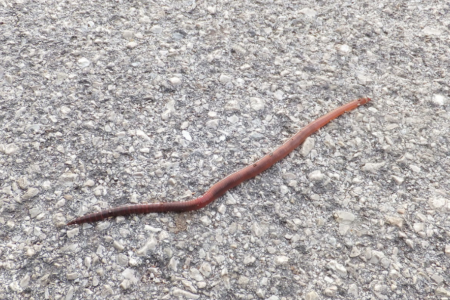
A cool scientific study on earthworms in Taiwan showed that more active species with higher oxygen demand came to the soil surface at night to get better absorption. In other words, while they weren’t going to drown in wet soil, their wet skin could better take in oxygen at the surface, so they moved up. Worms with lower oxygen demand didn’t do this, and did not drown in wet soils.
Hitting the road
Given the way that worms move, sliding across the surface of the ground is much faster than burrowing. It might also take less energy. For worms that got places to be, coming up to the surface might be an excellent option.

However, some major risks come with that, too. With the sun beating down or even a light breeze on a dry day, worms can dry out more easily above ground. They are also more vulnerable to predators like birds (especially robins) and small mammals. These problems might be part of why we don’t see worms sliding around when the weather is nice.
When it rains, though, conditions are much better for worms on the move. It’s wetter up topside, so they can avoid drying out. It also makes it easier and safer for them to slide along with less friction. Finally, some of the predators might be less active in rainy, wet conditions. All of these factors make it very likely that earthworms can move further, faster, and more safely during or after a rainstorm.
Why should worms want to move in the first place? Just like other animals and plants, there are plenty of reasons. These might include:
- Finding a mate
- Getting to a new or better habitat
- Avoiding predators
- Finding less crowded areas
Reacting to scary vibrations
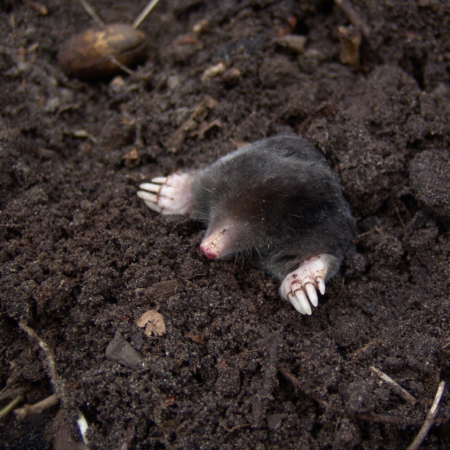
Since worms can’t see, they rely on their ability to sense vibrations to avoid getting chomped by predators. This helps them escape fossorial (underground or subterranean) predators like moles that would otherwise quickly find them. When they sense certain vibrations, worms will move toward the surface as an evasive action.
The prevailing idea, then, is that the vibrations caused by falling raindrops are similar to the vibrations of an approaching mole. This causes worms to take evasive action and move up to the surface, where they end up all over our lawns and sidewalks. While earthworms definitely do move in response to vibrations in the ground, this doesn’t necessarily mean that that’s why they come out when it rains. After all, worms still come out when there has only been a light rain, or even just mist, which doesn’t vibrate the ground.
Nonetheless, worms are sensitive to lots of different kinds of vibration. For example, researchers found that worms seem to avoid the vibrations caused by wind power turbines in the Netherlands.
Dancing and grunting for worms
Interestingly, people as well as other surface animal species have figured out how to use this to their advantage. Using a technique called “worm grunting”, people vibrate a stick or other object inserted into the ground. This confuses worms into moving upward in the soil to escape what might be a predator. At that point, they are much easier to capture for fishing bait or other uses! Naturalists have spotted wood turtles (Clemmys insculpta) and some gulls (Larus sp.) taking advantage of this behavior. In both cases, they find their own ways of making vibrations to lure earthworms closer to the surface.
Should you take worms off of the sidewalk or pavement?
Another question I hear often on this topic is what we can do to help stranded worms. If you find a live worm on the sidewalk after a rain, what should you do? While picking up a worm and moving it to soil is a good idea, there’s one major catch. The salt on your hands will be toxic to the worm and will dry out its skin. As we now know, that could really harm the worm and keep it from “breathing” properly. So here’s what you should do.

If you find a stranded worm on the sidewalk:
- Get your hands wet and muddy in a nearby puddle or bit of soil.
- Gently scoop up the worm, but minimize its contact with your bare (clean) skin.
- Take the worm to a nearby spot that is shaded and has moist, soft soil.
- Gently put the worm down and let it figure out its next move!
This way, you can really feel like you’re doing something valuable for these valuable invertebrates.
Thanks for reading about why worms come out when it rains!
If you’d like more info on Earthworms, be sure to check out the Nature Guys episode “A Can of Earthworms“. As always, if you have additional requests for Naturalist Answers posts or want to let me know what you think of the blog, use the Contact page to get in touch. Until next time!

